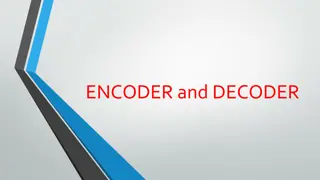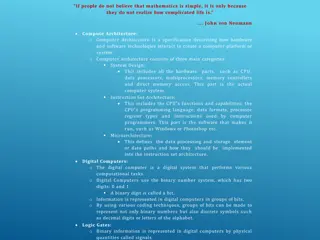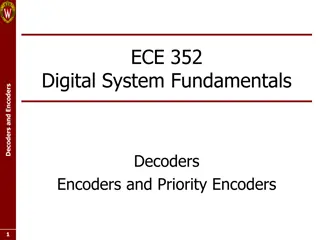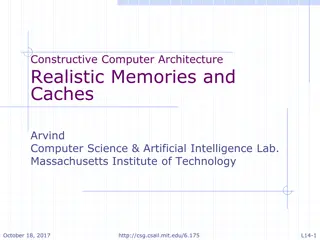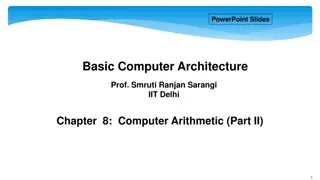Understanding Decoders and Multiplexers in Computer Architecture
Decoders and multiplexers are essential components in computer architecture, converting binary information efficiently. Integrated circuits house digital gates, enabling the functioning of these circuits. A decoder's purpose is to generate binary combinations, with examples like the 3-to-8-line decoder facilitating binary-to-octal conversion. Truth tables illustrate decoder operations, showing how outputs vary based on input combinations and enable signals.
Download Presentation

Please find below an Image/Link to download the presentation.
The content on the website is provided AS IS for your information and personal use only. It may not be sold, licensed, or shared on other websites without obtaining consent from the author. Download presentation by click this link. If you encounter any issues during the download, it is possible that the publisher has removed the file from their server.
E N D
Presentation Transcript
Computer Architecture Part III Decoders and Multiplexers Department of Computer Science, Faculty of Science, Chiang Mai University
Outline Integrated Circuits Decoders Multiplexers Registers Memory Unit 2 204231: Computer Organization and Architecture
Integrated Circuits An integrated circuit (abbreviated IC) is s mall silicon semiconductor crystal, called a chip, containing the electric components for the digital gates. 3 204231: Computer Organization and Architecture
Example of IC https://www.101computing.net/logic-gates-tester-kit/ 4 204231: Computer Organization and Architecture
Decoders A decoder is a combinational circuit that converts binary information from the n coded inputs to a maximum of 2nunique outputs. The decoders presented in this sections are called n-to-m-line decoders, where m 2n. Their purpose is to generate the 2n(or fewer) binary combinations of the n input variables. A decoder has n inputs and m outputs and is also referred to as an n m decoder. 5 204231: Computer Organization and Architecture
3-to-8-Line Decoder 6 204231: Computer Organization and Architecture
3-to-8-Line Decoder The three data inputs, A0, A1, and A2, are decoded into eight outputs, each output represent one of the combinations of the three binary input variables. A particular application of this decoder is a binary- to-octal conversion. Commercial decoders include one or more enable inputs to control the operation of the circuit. The decoder is enabled when E is equal to 1 and disabled when E is equal to 0. 7 204231: Computer Organization and Architecture
Truth Table for 3-to-8-Line Decoder When the enable input E is equal to 0, all the outputs are equal to 0 regardless of the values of the other there data inputs. The there x s in the table designate don t-care conditions. When the enable input is equal to 1, the decoder operates in a normal fashion. 8 204231: Computer Organization and Architecture
Truth Table for 3-to-8-Line Decoder For each possible input combination, there are seven outputs that are equal to 0 and only one that is equal to 1. The output variable whose value is equal to 1 represents the octal number equivalent of the binary number that is available in the input data lines. 9 204231: Computer Organization and Architecture
Truth Table for 3-to-8-Line Decoder 10 204231: Computer Organization and Architecture
NAND Gate Decoder Some decoders are constructed with NAND instead of AND gates. The decoder is enabled when E is equal to 0. As indicated by the truth table, only one output is equal to 0 at any give time; the other three outputs are equal to 1. 11 204231: Computer Organization and Architecture
NAND Gate Decoder The output whose value is equal to 0 represents the equivalent binary number in inputs A1and A0. The circuit is disabled when E is equal to 1, regardless of the values of the other two inputs. 12 204231: Computer Organization and Architecture
2-to-4-Line Decoder with NAND Gates 13 204231: Computer Organization and Architecture
Decoder Expansion Two 2-to-4-line decoders are combined to achieve a 3-to-8-line decoder. The two least significant bits of the input are connected to both decoders. The most significant bit is connected to the enable input of one decoder and through an inverter to the enable input of the other decoder. 14 204231: Computer Organization and Architecture
Decoder Expansion It is assumed that each decoder is enabled when its E input is equal to 1. When E is equal to 0, the decoder is disabled and all its outputs are in the 0 level. When A2= 0, the upper decoder is enabled and the lower is disabled. 15 204231: Computer Organization and Architecture
Decoder Expansion The outputs of the upper decoder generate outputs D0through D3, depending on the values of A1and A0. When A2= 1, the lower decoder is enabled and the upper is disabled. The lower decoder output generates the binary equivalent D4through D7. 16 204231: Computer Organization and Architecture
3 8 Decoder Constructed with Two 2 4 Decoders 17 204231: Computer Organization and Architecture
Multiplexers A multiplexer is a combinational circuit that receives binary information from one of 2ninput data lines and directs it to a single output line. The selection of a particular input data line for the output is determined by a set of selection inputs. A 2n-to-1 multiplexer has 2ninput data lines and n input selection lines whose bit combinations determine which input data are selected for the output. 18 204231: Computer Organization and Architecture
4-to-1-Line Multiplexer Each of the four data inputs I0through I3is applied to one input of and AND gate. The two selection inputs S1and S0are decoded to select a particular AND gate. The outputs of the AND gates are applied to a single OR gate to provide the single output. A more convenient way to describe the operation of multiplexers is by means of a function table. 19 204231: Computer Organization and Architecture
4-to-1-Line Multiplexer 20 204231: Computer Organization and Architecture
Function Table for 4-to-1-Line Multiplexer 21 204231: Computer Organization and Architecture
Quadruple 2-to-1-Line Multiplexer One or more multiplexers can be enclosed with in a single integrated circuit. The selection and the enable inputs in multiple-unit construction are usually common to all multiplexers. Quadruple 2-to-1-line multiplexer has four multiplexers. 22 204231: Computer Organization and Architecture
Quadruple 2-to-1-Line Multiplexer 23 204231: Computer Organization and Architecture
Registers In its broadest definition, a register consists of a group of flip-flops and gates that effect their transition. The flip-flops hold the binary information and the gates control when and how new information is transferred into the register. 24 204231: Computer Organization and Architecture
4-Bit Register The register is constructed with four D flip- flops. The common clock input triggers all flip-flops on the rising edge of each pulse, and the binary data available at the four inputs are transferred into the 4-bit register. The four outputs can be sampled at any time to obtain the binary information stored in the register. 25 204231: Computer Organization and Architecture
4-Bit Register The clear input goes to a special terminal in each flip-flop. When this input goes to 0, all flip-flops are reset asynchronously. The clear input is useful for clearing the register to all 0 s prior to its clocked operation. 26 204231: Computer Organization and Architecture
4-Bit register 27 204231: Computer Organization and Architecture
Shift Registers A register capable of shifting its binary information in one or both directions is called a shift register. The logical configuration of a shift register consists of a chain of flip-flops in cascade, with the output of one flip-flop connected to the input of the next flip-flop. All flip-flop receive common clock pulses that initiate the shift from one stage to the next. 28 204231: Computer Organization and Architecture
4-Bit Shift Register 29 204231: Computer Organization and Architecture
Random-Access Memory The n data input lines provide the information to be stored in memory, and the n data output lines supply the information coming out of memory. The k address lines provide a binary number of k bits that specify a particular word chosen among the 2kavailable inside the memory. The two control inputs specify the direction of transfer desired. 30 204231: Computer Organization and Architecture
Block Diagram of Random Access Memory (RAM) 31 204231: Computer Organization and Architecture
Transferring a New Word to be Stored into Memory 1. Apply the binary address of the desired word into the address lines. 2. Apply the data bits that must be stored in memory into the data input lines. 3. Activate the write input. 32 204231: Computer Organization and Architecture
Transferring a Stored Word Out of Memory 1. Apply the binary address of the desired word into the address lines. 2. Activate the read input. 33 204231: Computer Organization and Architecture
Read-Only Memory An m x n ROM is an array of binary cells organized into m words of n bits each. A ROM has k address input lines to select one of 2k= m words of memory, and n output lines, one for each bit of the word. The ROM does not need a read-control line since at any given time, the output lines automatically provide the n bits of the word selected by the address value. 34 204231: Computer Organization and Architecture
Block Diagram of Read Only Memory (ROM) 35 204231: Computer Organization and Architecture
Reference M. Moris Mano, Computer System Architecture, 3rded. NJ: Prentice Hall, 1992. 36 204231: Computer Organization and Architecture
37 204231: Computer Organization and Architecture
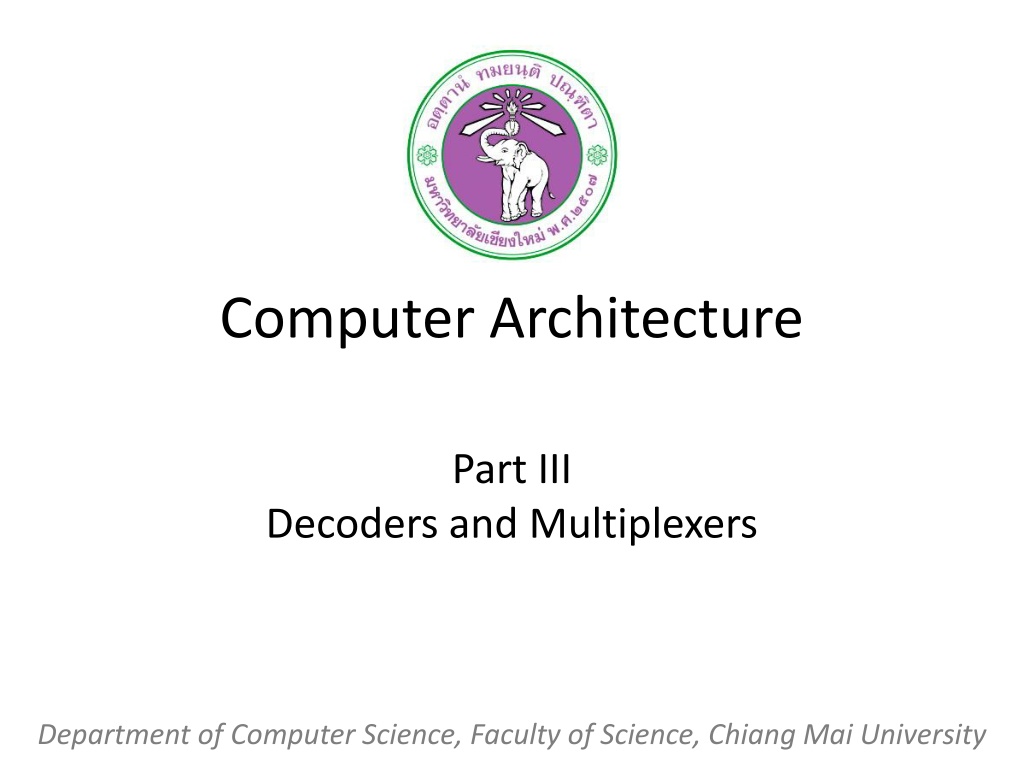


![❤Book⚡[PDF]✔ The Apollo Guidance Computer: Architecture and Operation (Springer](/thumb/21611/book-pdf-the-apollo-guidance-computer-architecture-and-operation-springer.jpg)


